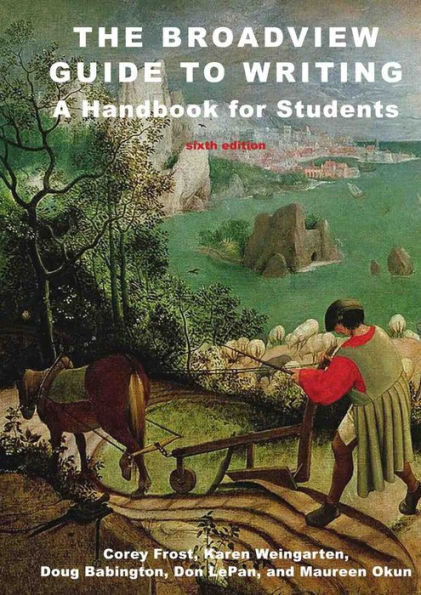Key Features
- —A coil-bound reference text suitable for a range of introductory composition and writing courses
—Divided into three sections:
- Writing Processes (including Research, Argumentation, and Style)
Writing Mechanics (Grammar, Usage, and Punctuation)
Writing Contexts (Writing in different academic disciplines, Forms and conventions, and citation)
—Comprehensive treatment of citation style guides, with 2016 MLA style updates
—Expanded treatment of research methods, argument structures, and writing in the workplace
—A unique section on “How to Be Good With Words”—issues of gender, race, class, religion, sexual orientation, disability, etc.
—Expanded coverage for those whose native language is not English
—All-new chapter on reading images
—Extensive companion website featuring interactive exercises
Increasingly, writing handbooks are seen as over-produced and overpriced. One stands out: The Broadview Guide to Writing is published in an elegant but simple format, and sells for roughly half the price of its fancier-looking competitors. That does not change with the new edition; what does change and stay up-to-date is the content of the book. The sixth edition brings a substantial re-organization of the contents under three headings: Writing Processes, Writing Mechanics, and Writing Contexts. Coverage of APA, Chicago, and CSE styles of documentation has been substantially expanded, and the MLA section has now been fully revised to take into account all the 2016 changes. Also expanded is coverage of academic argument; of writing and critical thinking; of writing about literature, of paragraphing; of how to integrate quoted material into one’s own work; of balance and parallelism; and of issues of gender, race, religion etc. in writing. The chapter “Seeing and Meaning: Reading (and Writing About) Visual Images” is entirely new to the sixth edition.
Key Features
- —A coil-bound reference text suitable for a range of introductory composition and writing courses
—Divided into three sections:
- Writing Processes (including Research, Argumentation, and Style)
Writing Mechanics (Grammar, Usage, and Punctuation)
Writing Contexts (Writing in different academic disciplines, Forms and conventions, and citation)
—Comprehensive treatment of citation style guides, with 2016 MLA style updates
—Expanded treatment of research methods, argument structures, and writing in the workplace
—A unique section on “How to Be Good With Words”—issues of gender, race, class, religion, sexual orientation, disability, etc.
—Expanded coverage for those whose native language is not English
—All-new chapter on reading images
—Extensive companion website featuring interactive exercises
Increasingly, writing handbooks are seen as over-produced and overpriced. One stands out: The Broadview Guide to Writing is published in an elegant but simple format, and sells for roughly half the price of its fancier-looking competitors. That does not change with the new edition; what does change and stay up-to-date is the content of the book. The sixth edition brings a substantial re-organization of the contents under three headings: Writing Processes, Writing Mechanics, and Writing Contexts. Coverage of APA, Chicago, and CSE styles of documentation has been substantially expanded, and the MLA section has now been fully revised to take into account all the 2016 changes. Also expanded is coverage of academic argument; of writing and critical thinking; of writing about literature, of paragraphing; of how to integrate quoted material into one’s own work; of balance and parallelism; and of issues of gender, race, religion etc. in writing. The chapter “Seeing and Meaning: Reading (and Writing About) Visual Images” is entirely new to the sixth edition.

The Broadview Guide to Writing: A Handbook for Students - Sixth Edition
760
The Broadview Guide to Writing: A Handbook for Students - Sixth Edition
760(Spiral Bound - New Edition)

Product Details
| ISBN-13: | 9781554813131 |
|---|---|
| Publisher: | Broadview Press |
| Publication date: | 05/30/2017 |
| Edition description: | New Edition |
| Pages: | 760 |
| Product dimensions: | 5.50(w) x 8.50(h) x (d) |
